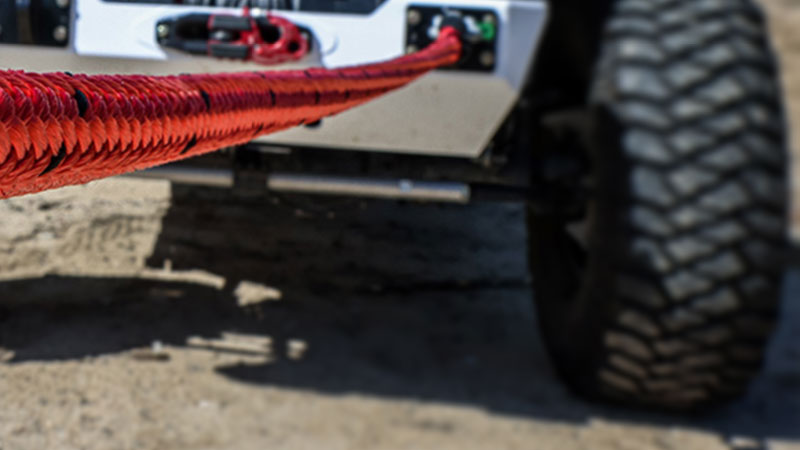When it comes to off-roading, one of the most essential tools in your arsenal is a reliable recovery rope. But what kind of rope do off-roaders use for recovery? In this comprehensive guide, we will discuss the various types of ropes available for off-road recovery, their features, and how to select the perfect one for your needs. We will also answer some frequently asked questions to provide you with a complete understanding of this crucial off-roading accessory.
Contents
What Kind of Rope Do Off-Roaders Use for Recovery
1. Synthetic Winch Ropes: The Off-Road Recovery Champion
Features and Benefits of Synthetic Winch Ropes
Synthetic winch ropes are the preferred choice for many off-roaders due to their unique properties that make them ideal for recovery situations. Some key features and benefits include:
- Lightweight: Synthetic winch ropes are significantly lighter than steel cables, making them easier to handle and transport.
- High strength: Despite their lightweight nature, synthetic winch ropes boast impressive strength, capable of handling heavy loads.
- Safer to use: If a synthetic winch rope breaks, it does not store as much energy as a steel cable, reducing the risk of injury.
- Easy to maintain: Synthetic winch ropes are resistant to rust and require less maintenance compared to steel cables.
How to Choose the Right Synthetic Winch Rope
When selecting a synthetic winch rope, consider the following factors:
- Load capacity: Ensure the rope can handle the weight of your vehicle.
- Length: Choose a rope long enough to accommodate your recovery needs.
- Diameter: A thicker rope provides greater strength but may be heavier and more challenging to handle.
2. Kinetic Recovery Ropes: The Flexible Alternative
Features and Benefits of Kinetic Recovery Ropes
Kinetic recovery ropes are another popular option among off-roaders due to their elasticity and shock-absorbing properties. Key features and benefits include:
- Stretch and recoil: The elasticity of kinetic ropes allows them to stretch and recoil, providing a smoother and more efficient recovery process.
- Reduced stress on vehicles: The shock-absorbing properties of kinetic ropes help reduce stress on both the recovering and stuck vehicles.
- Versatility: Kinetic ropes can be used for various recovery situations, including snatching and towing.
How to Choose the Right Kinetic Recovery Rope
When selecting a kinetic recovery rope, consider the following factors:
- Load capacity: Ensure the rope can handle the weight of your vehicle.
- Length: Choose a rope long enough to accommodate your recovery needs.
- Diameter: A thicker rope provides greater strength but may be heavier and more challenging to handle.
3. Tow Straps: A Classic Choice for Off-Road Recovery
Features and Benefits of Tow Straps
Tow straps have long been used for off-road recovery and continue to be a reliable option. Some key features and benefits include:
- Cost-effective: Tow straps are generally more affordable than synthetic winch ropes and kinetic recovery ropes.
- Durability: Tow straps are made from tough materials like polyester or nylon, ensuring they can withstand harsh off-road conditions.
- Easy to use: Tow straps can be quickly attached and detached, making them a convenient option for recovery situations.
How to Choose the Right Tow Strap
When selecting a tow strap, consider the following factors:
- Load capacity: Ensure the strap can handle the weight of your vehicle.
- Length: Choose a strap long enough to accommodate your recovery needs.
- Material: Look for durable materials like polyester or nylon that can withstand harsh off-road conditions.
Frequently Asked Questions
What is the difference between a winch rope and a recovery rope?
A winch rope is specifically designed for use with a winch, providing a strong and reliable means of pulling a vehicle out of a difficult situation. Recovery ropes, on the other hand, can include
winch ropes, kinetic recovery ropes, and tow straps, all of which serve different purposes in off-road recovery situations.
How do I properly maintain my off-road recovery rope?
Proper maintenance of your recovery rope will ensure its longevity and performance. After each use, inspect the rope for damage, clean it of any dirt or debris, and allow it to dry thoroughly before storing. Periodically check for signs of wear or fraying and replace the rope if necessary.
Can I use a regular rope for off-road recovery?
It is not recommended to use a regular rope for off-road recovery, as they lack the strength, durability, and specialized features of ropes specifically designed for this purpose. Using a regular rope could lead to failure and potential injury during a recovery situation.
How do I determine the right load capacity for my recovery rope?
To determine the appropriate load capacity for your recovery rope, consider the weight of your vehicle and any additional equipment or cargo. A general rule of thumb is to choose a rope with a load capacity rated at least 2 to 3 times the weight of your vehicle.
Can I use a tow strap with a winch?
While it is technically possible to use a tow strap with a winch, it is not recommended. Tow straps are not designed for use with winches and may not have the necessary strength or durability to handle the forces involved in winching. Instead, opt for a synthetic winch rope specifically designed for winch applications.
Final Words
Understanding what kind of rope off-roaders use for recovery is crucial for safe and effective off-roading adventures. By evaluating your specific needs and considering the features and benefits of synthetic winch ropes, kinetic recovery ropes, and tow straps, you can make an informed decision and select the perfect rope for your off-road recovery toolkit. Always prioritize safety and proper maintenance to ensure the longevity and performance of your recovery rope.
